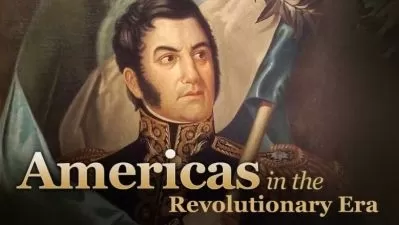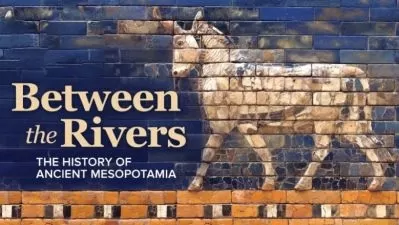Lost Worlds of South America
Edwin Barnhart
11:54:00
Description
The dramatic terrain of South America is one of the great and thrilling frontiers of archaeology. Buried by the centuries on soaring mountain slopes and beneath arid deserts and lush jungles, the remains of extraordinary, majestic civilizations—many completely unknown until recent decades—are now coming to light and raising tantalizing questions about what else may be awaiting discovery.
These newly uncovered sites, as well as previously known ones such as Cuzco and Machu Picchu, are by no means those of simple, “primitive” cultures, but show astonishing sophistication in large-scale architecture, agricultural systems, art, and urban organization, together with technological ingenuity that dazzles the imagination.
As one of only six places on earth where civilization arose spontaneously, this region offers a fresh and revelatory look at how human societies formed, from the earliest organized communities to cultures of huge complexity. They paralleled, yet were absolutely different from, the ancient cultures of Greece, Egypt, and others that we know so much better. In these sites you witness, with vivid clarity, the unfolding of one of the true cradles of civilization.
Now, in Lost Worlds of South America, Professor Edwin Barnhart, director of the Maya Exploration Center, leads you on an adventurous trek of discovery through the wilds of South America to the great, mysterious civilizations of the ancients. In 24 eye-opening lectures, you’ll take an in-depth look at the emerging finds and archaeological knowledge of more than 12 seminal civilizations, giving you rich insight into the creative vision and monumental achievements of these wellsprings of human life.
A Startling New Glimpse of the Ancient World
The ancient South Americans show us striking models of how societies can function and organize themselves. The technologies and social structures seen here were wholly invented, using no preexisting models, as these dynamic peoples struggled to tame their environment and carve out societies and empires.
Recently unearthed marvels include
- elaborately prepared and adorned mummies that predate Egypt’s by 2000 years;
- imposing palaces, solar observatories, and dramatically decorated pyramids;
- massive irrigation systems, aquaducts, and canals;
- brilliantly engineered road systems covering thousands of kilometers;
- stunning art objects in gold, turquoise, lapis lazuli, and ceramic; and
- evidence of huge urban civilizations in the Amazon.
In their amazing sophistication and scale, the sites reveal some of the most remarkable ancient artifacts found anywhere in the world. These cultures rank among the greatest early civilizations, providing an extraordinary window on the development of human societies—and we’ve seen only the beginnings of these archaeological discoveries.
Encounter an Astounding Legacy of History and Culture
In many cases, the finds you investigate are so new that the only way to follow them is through primary sources: the archaeologists and scholars working in the field, and the materials they have brought to light. As an archaeologist, explorer, and passionate advocate for these cultures, Professor Barnhart invites you to join him at the latest excavation sites and to discover this hugely exciting field.
As a key point of the course, the professor elucidates how the iconic Inca civilization was only the tail end of a long, unfolding progression of cultures, and that the Inca stood on the shoulders of other great civilizations such as the Nazca, Moche, Wari, and Chimú. Your journey covers numerous illuminating facets of these cultures and ways of life, including these:
- Earliest cities in the Americas: Explore the first urban complexes in the New World, dating to 3000 B.C.—their remarkable architectural features of platform mounds, sunken plazas, great pyramid-like structures, and irrigation channels, and the means by which these cultures supported large populations.
- Wonders of ancient technology: Throughout the series, grapple with the amazing technological innovations of the early South Americans, including the astronomical observatories of Chankillo, the complex hydraulic engineering of the Nazca, the anti-seismic architecture of the Wari, the “raised field” agriculture of Tiwanaku—and the Inca’s technique, centuries ahead of its time, of freeze-drying vegetables.
- Mummies, headhunting, and fanged deities: In cultures from the Paracas and Wari to the Inca, discover the religious underpinnings, cosmology, and significance of cultural practices such as mummification, ancestor worship, severed heads, human sacrifice, and ancient “brain surgery.”
- The great Moche civilization: In three lectures on this visionary people, reckon with their towering pyramids, adorned with brilliant color murals; their fabulous tombs—the richest and most lavish in the New World—and their elaborate practices of shamanic healing.
- Glories of Andean art: Drawing from the many cultures you visit, witness the mastery of metallurgy, textiles, and ceramics, and the rich iconography seen in sumptuous ritual objects, jewelry, clothing, and personal adornment.
- The magnificent Inca: In six lectures, learn how the Inca forged an empire of 10 million people, organized it through a system of “labor taxation,” ended hunger in their world, and built the glittering city of Cuzco—laid out in the shape of a crouching puma and boasting grand avenues, fountains, palaces, and temples with walls of hammered gold.
A Richly Colorful Journey
Professor Barnhart enhances the history with stories of his own adventures and firsthand accounts of the sites and regions in question. You join him by video at the site of the fascinating Nazca geoglyphs to learn how the Nazca people etched vast geometric designs into the earth. You hear of hair-raising incidents pitting archaeologists against daring looters, and of Professor Barnhart’s own work of attempting to penetrate the enigma of the Inca’s “impossibly” perfect stonework.
The ancient cultures come alive through hundreds of original photographs, taken by Professor Barnhart and other archaeologists working in the field, illuminating the architecture, artifacts, and artworks, as well as 3-D models that vividly reveal the sites themselves.
A Story beyond Imagining
Armed with a probing investigative spirit, Professor Barnhart takes you deeply into the mysteries of these civilizations, raising compelling questions about how these peoples lived, worked, prayed, and thought.
He leads you on an investigation of cryptic iconography on Moche ceramics and imagery suggesting that Moche priests incarnated or “channeled” the culture’s creator deity. With his expert guidance, you’ll probe what may have underlain the mass sacrifice of young women in the Sican culture. And you’ll trace startling connections between the ways of life of the ancients and those of present-day peoples in South America.
You’ll be riveted as you delve into one of the last unbroken ancient codes—the system of writing in knotted strings called “khipu”—and learn how the early South Americans shared meals with their mummified ancestors. And you’ll be amazed as you track huge canal systems, mounds, raised causeways, and fish farms indicating wide-scale civilization in the “untamable” jungles, all made possible by recent dramatic discoveries in the Amazon.
In Lost Worlds of South America, the breathtaking valleys, mountains, and deserts reveal wonders that rival anything we know of the ancient world. Travel with us to a lost and splendorous past—a fountainhead of civilization that speaks unforgettably of human striving, vision, and the indomitable will to endure.
More details
User Reviews
Rating
Edwin Barnhart
Instructor's CoursesDr. Edwin Barnhart is director of the Maya Exploration Center. He holds a Ph.D. from the University of Texas at Austin and has over 20 years of experience in North, Central, and South America as an archaeologist, explorer, and instructor. In 1994, Professor Barnhart discovered the ancient city of Maax Na (Spider-Monkey House), a major center of the Classic Maya period in northwestern Belize. In 1998 he was invited by the Mexican government to direct the Palenque Mapping Project, a three-year effort to survey and map the unknown sections of Palenque's ruins. The resultant map has been celebrated as one of the most detailed and accurate ever made of a Maya ruin. In 2003, he became the director of Maya Exploration Center, a nonprofit organization dedicated to the study of ancient Maya civilization. The center leads study-abroad courses for college students and tours for the general public in the ruins of the ancient Americas, among its other research and educational activities. Professor Barnhart has taught archaeology and anthropology at Southwest Texas State University, and currently teaches University of Texas travel courses for college professors on ancient Andean and Mesoamerican astronomy, mathematics, and culture. Over the last 10 years, he has appeared multiple times on the History Channel, the Discovery Channel, and Japanese NHK Public Television. He has published over a dozen papers and given presentations at eight international conferences.

The Great Courses
View courses The Great Courses- language english
- Training sessions 24
- duration 11:54:00
- English subtitles has
- Release Date 2023/06/06
















